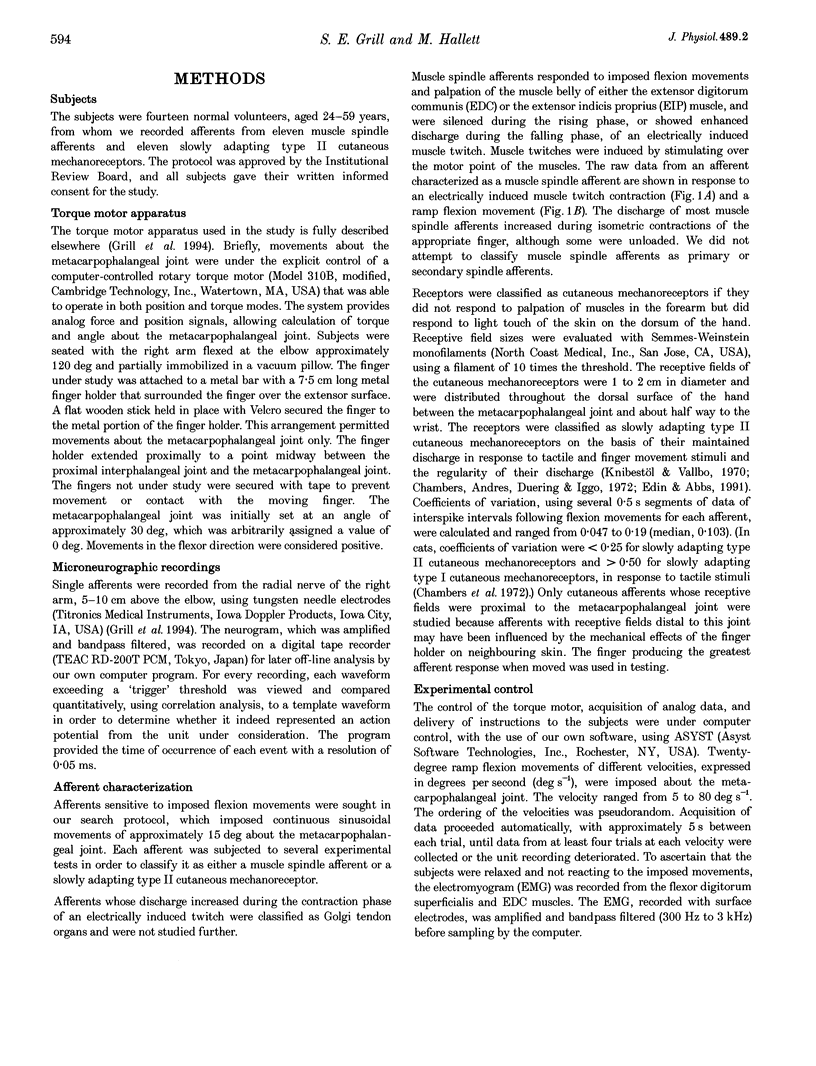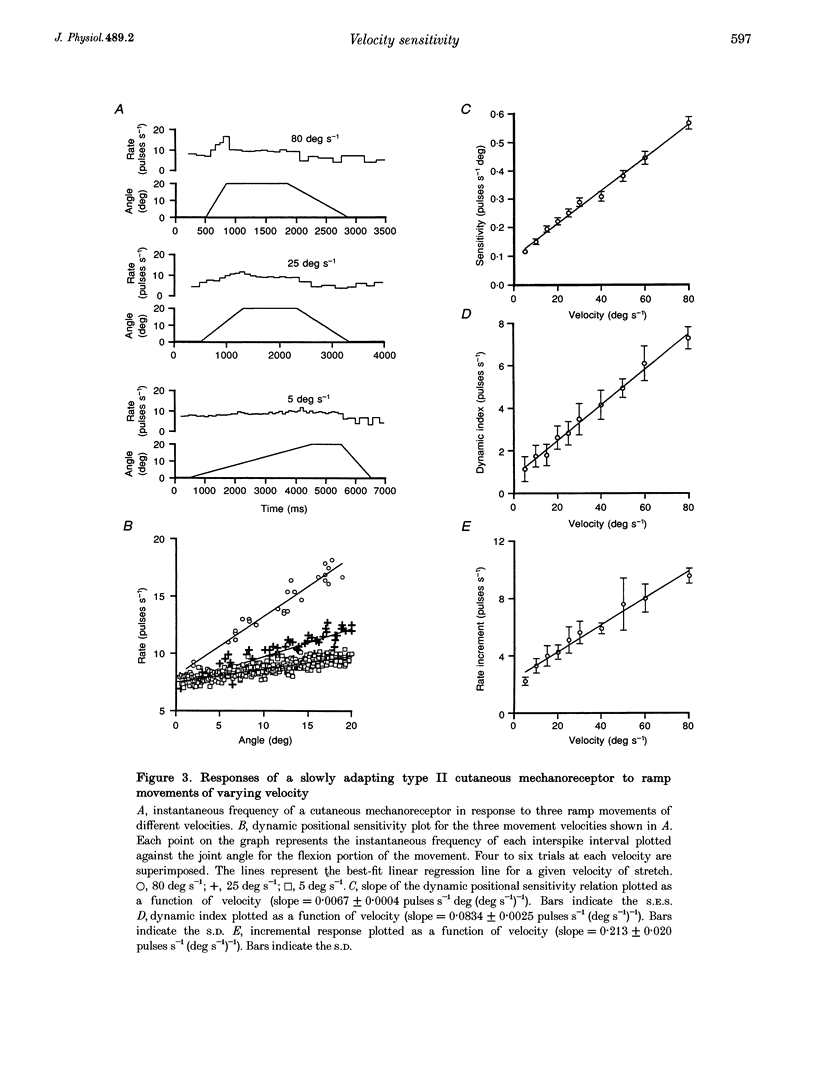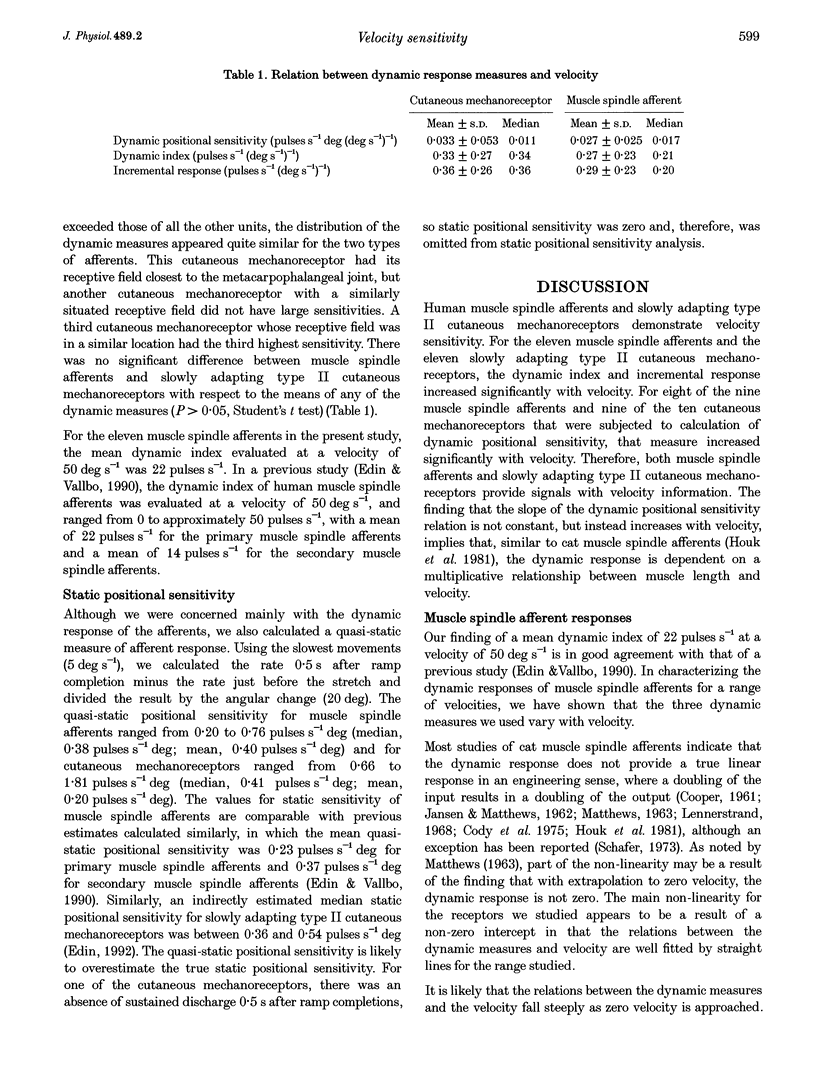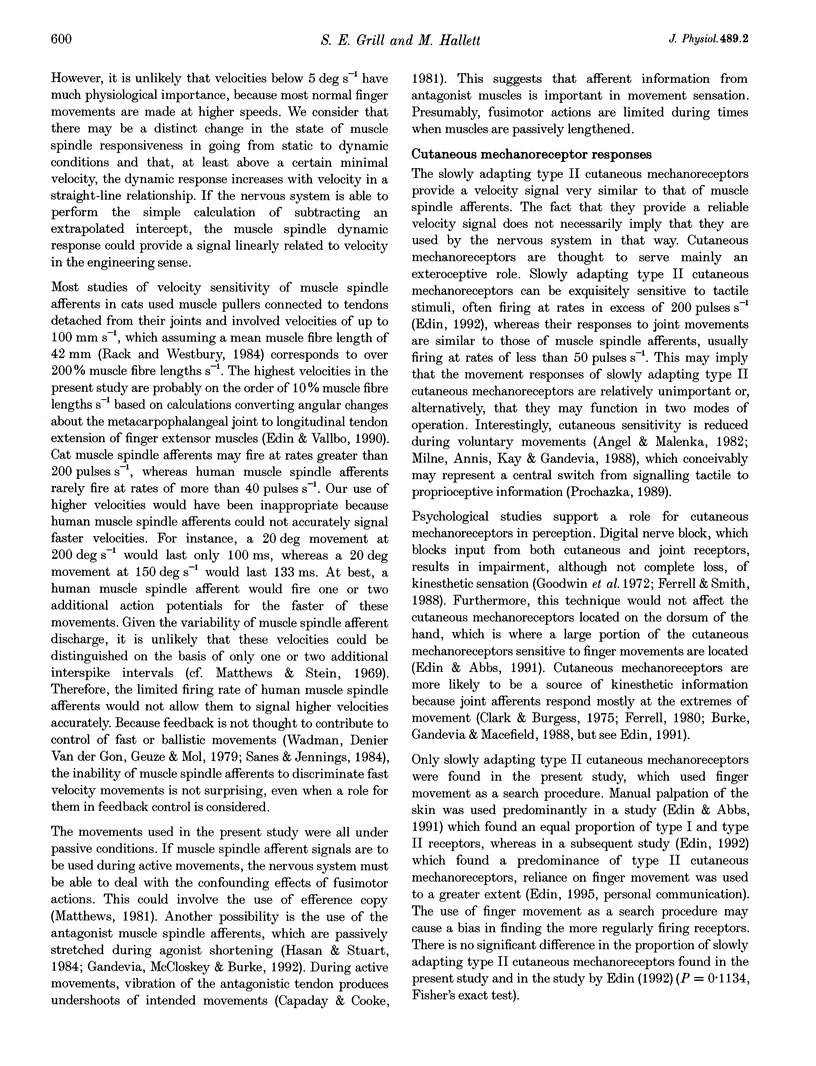Abstract
1. Velocity information is used in the performance of movement. This study evaluated the ability of peripheral receptors to signal velocity in human subjects. 2. The velocity sensitivity of human muscle spindle afferents from the extensor digitorum muscles and slowly adapting type II cutaneous mechanoreceptors on the dorsum of the hand was evaluated with recordings from the radial nerve during imposed flexion movements about the metacarpophalangeal joint. Twenty-degree movements at velocities ranging from 5 to 80 deg s-1 were used. 3. Three measures of dynamic response were calculated: the dynamic positional sensitivity (the relation between discharge rate and joint angle during the dynamic phase of movement), the dynamic index (the discharge rate just before ramp completion minus the rate 0.5 s later), and the incremental response (the discharge rate just before ramp completion minus the rate just before ramp onset). 4. Both muscle spindle afferents and slowly adapting type II cutaneous mechanoreceptors demonstrated significant velocity sensitivity. The magnitudes of the relations between dynamic response measures and velocity were similar in the two receptor types. 5. These findings are consistent with the view that both muscle spindle afferents and slowly adapting type II cutaneous mechanoreceptors provide reasonable velocity signals.
Full text
PDF









Selected References
These references are in PubMed. This may not be the complete list of references from this article.
- Angel R. W., Malenka R. C. Velocity-dependent suppression of cutaneous sensitivity during movement. Exp Neurol. 1982 Aug;77(2):266–274. doi: 10.1016/0014-4886(82)90244-8. [DOI] [PubMed] [Google Scholar]
- Burgess P. R., Clark F. J. Characteristics of knee joint receptors in the cat. J Physiol. 1969 Aug;203(2):317–335. doi: 10.1113/jphysiol.1969.sp008866. [DOI] [PMC free article] [PubMed] [Google Scholar]
- Burke D., Gandevia S. C., Macefield G. Responses to passive movement of receptors in joint, skin and muscle of the human hand. J Physiol. 1988 Aug;402:347–361. doi: 10.1113/jphysiol.1988.sp017208. [DOI] [PMC free article] [PubMed] [Google Scholar]
- COOPER S. The responses of the primary and secondary endings of muscle spindles with intact motor innervation during applied stretch. Q J Exp Physiol Cogn Med Sci. 1961 Oct;46:389–398. doi: 10.1113/expphysiol.1961.sp001558. [DOI] [PubMed] [Google Scholar]
- Capaday C., Cooke J. D. The effects of muscle vibration on the attainment of intended final position during voluntary human arm movements. Exp Brain Res. 1981;42(2):228–230. doi: 10.1007/BF00236912. [DOI] [PubMed] [Google Scholar]
- Chambers M. R., Andres K. H., von Duering M., Iggo A. The structure and function of the slowly adapting type II mechanoreceptor in hairy skin. Q J Exp Physiol Cogn Med Sci. 1972 Oct;57(4):417–445. doi: 10.1113/expphysiol.1972.sp002177. [DOI] [PubMed] [Google Scholar]
- Cody F. W., Harrison L. M., Taylor A. Analysis of activity of muscle spindles of the jaw-closing muscles during normal movements in the cat. J Physiol. 1975 Dec;253(2):565–582. doi: 10.1113/jphysiol.1975.sp011207. [DOI] [PMC free article] [PubMed] [Google Scholar]
- Cordo P. J. Kinesthetic control of a multijoint movement sequence. J Neurophysiol. 1990 Jan;63(1):161–172. doi: 10.1152/jn.1990.63.1.161. [DOI] [PubMed] [Google Scholar]
- Cordo P., Carlton L., Bevan L., Carlton M., Kerr G. K. Proprioceptive coordination of movement sequences: role of velocity and position information. J Neurophysiol. 1994 May;71(5):1848–1861. doi: 10.1152/jn.1994.71.5.1848. [DOI] [PubMed] [Google Scholar]
- Edin B. B., Abbs J. H. Finger movement responses of cutaneous mechanoreceptors in the dorsal skin of the human hand. J Neurophysiol. 1991 Mar;65(3):657–670. doi: 10.1152/jn.1991.65.3.657. [DOI] [PubMed] [Google Scholar]
- Edin B. B., Abbs J. H. Finger movement responses of cutaneous mechanoreceptors in the dorsal skin of the human hand. J Neurophysiol. 1991 Mar;65(3):657–670. doi: 10.1152/jn.1991.65.3.657. [DOI] [PubMed] [Google Scholar]
- Edin B. B. Quantitative analysis of static strain sensitivity in human mechanoreceptors from hairy skin. J Neurophysiol. 1992 May;67(5):1105–1113. doi: 10.1152/jn.1992.67.5.1105. [DOI] [PubMed] [Google Scholar]
- Edin B. B., Vallbo A. B. Dynamic response of human muscle spindle afferents to stretch. J Neurophysiol. 1990 Jun;63(6):1297–1306. doi: 10.1152/jn.1990.63.6.1297. [DOI] [PubMed] [Google Scholar]
- Ferrell W. R., Craske B. Contribution of joint and muscle afferents to position sense at the human proximal interphalangeal joint. Exp Physiol. 1992 Mar;77(2):331–342. doi: 10.1113/expphysiol.1992.sp003592. [DOI] [PubMed] [Google Scholar]
- Ferrell W. R., Gandevia S. C., McCloskey D. I. The role of joint receptors in human kinaesthesia when intramuscular receptors cannot contribute. J Physiol. 1987 May;386:63–71. doi: 10.1113/jphysiol.1987.sp016522. [DOI] [PMC free article] [PubMed] [Google Scholar]
- Ferrell W. R., Smith A. Position sense at the proximal interphalangeal joint of the human index finger. J Physiol. 1988 May;399:49–61. doi: 10.1113/jphysiol.1988.sp017067. [DOI] [PMC free article] [PubMed] [Google Scholar]
- Gandevia S. C. Illusory movements produced by electrical stimulation of low-threshold muscle afferents from the hand. Brain. 1985 Dec;108(Pt 4):965–981. doi: 10.1093/brain/108.4.965. [DOI] [PubMed] [Google Scholar]
- Gandevia S. C., McCloskey D. I., Burke D. Kinaesthetic signals and muscle contraction. Trends Neurosci. 1992 Feb;15(2):62–65. doi: 10.1016/0166-2236(92)90028-7. [DOI] [PubMed] [Google Scholar]
- Goodwin G. M., McCloskey D. I., Matthews P. B. The contribution of muscle afferents to kinaesthesia shown by vibration induced illusions of movement and by the effects of paralysing joint afferents. Brain. 1972;95(4):705–748. doi: 10.1093/brain/95.4.705. [DOI] [PubMed] [Google Scholar]
- Grill S. E., Hallett M., Marcus C., McShane L. Disturbances of kinaesthesia in patients with cerebellar disorders. Brain. 1994 Dec;117(Pt 6):1433–1447. doi: 10.1093/brain/117.6.1433. [DOI] [PubMed] [Google Scholar]
- Houk J. C., Rymer W. Z., Crago P. E. Dependence of dynamic response of spindle receptors on muscle length and velocity. J Neurophysiol. 1981 Jul;46(1):143–166. doi: 10.1152/jn.1981.46.1.143. [DOI] [PubMed] [Google Scholar]
- Hulliger M., Nordh E., Thelin A. E., Vallbo A. B. The responses of afferent fibres from the glabrous skin of the hand during voluntary finger movements in man. J Physiol. 1979 Jun;291:233–249. doi: 10.1113/jphysiol.1979.sp012809. [DOI] [PMC free article] [PubMed] [Google Scholar]
- JANSEN J. K., MATTHEWS P. B. The central control of the dynamic response of muscle spindle receptors. J Physiol. 1962 May;161:357–378. doi: 10.1113/jphysiol.1962.sp006892. [DOI] [PMC free article] [PubMed] [Google Scholar]
- Knibestöl M., Vallbo A. B. Single unit analysis of mechanoreceptor activity from the human glabrous skin. Acta Physiol Scand. 1970 Oct;80(2):178–195. doi: 10.1111/j.1748-1716.1970.tb04783.x. [DOI] [PubMed] [Google Scholar]
- Lennerstrand G. Position and velocity sensitivity of muscle spindles in the cat. I. Primary and secondary endings deprived of fusimotor activation. Acta Physiol Scand. 1968 Jul;73(3):281–299. doi: 10.1111/j.1748-1716.1968.tb04106.x. [DOI] [PubMed] [Google Scholar]
- MATTHEWS P. B. THE RESPONSE OF DE-EFFERENTED MUSCLE SPINDLE RECEPTORS TO STRETCHING AT DIFFERENT VELOCITIES. J Physiol. 1963 Oct;168:660–678. doi: 10.1113/jphysiol.1963.sp007214. [DOI] [PMC free article] [PubMed] [Google Scholar]
- Matthews P. B. Evolving views on the internal operation and functional role of the muscle spindle. J Physiol. 1981 Nov;320:1–30. doi: 10.1113/jphysiol.1981.sp013931. [DOI] [PMC free article] [PubMed] [Google Scholar]
- Matthews P. B., Stein R. B. The regularity of primary and secondary muscle spindle afferent discharges. J Physiol. 1969 May;202(1):59–82. doi: 10.1113/jphysiol.1969.sp008795. [DOI] [PMC free article] [PubMed] [Google Scholar]
- Milne R. J., Aniss A. M., Kay N. E., Gandevia S. C. Reduction in perceived intensity of cutaneous stimuli during movement: a quantitative study. Exp Brain Res. 1988;70(3):569–576. doi: 10.1007/BF00247604. [DOI] [PubMed] [Google Scholar]
- Moberg E. The role of cutaneous afferents in position sense, kinaesthesia, and motor function of the hand. Brain. 1983 Mar;106(Pt 1):1–19. doi: 10.1093/brain/106.1.1. [DOI] [PubMed] [Google Scholar]
- Prochazka A. Sensorimotor gain control: a basic strategy of motor systems? Prog Neurobiol. 1989;33(4):281–307. doi: 10.1016/0301-0082(89)90004-x. [DOI] [PubMed] [Google Scholar]
- Rack P. M., Westbury D. R. Elastic properties of the cat soleus tendon and their functional importance. J Physiol. 1984 Feb;347:479–495. doi: 10.1113/jphysiol.1984.sp015077. [DOI] [PMC free article] [PubMed] [Google Scholar]
- Sainburg R. L., Poizner H., Ghez C. Loss of proprioception produces deficits in interjoint coordination. J Neurophysiol. 1993 Nov;70(5):2136–2147. doi: 10.1152/jn.1993.70.5.2136. [DOI] [PMC free article] [PubMed] [Google Scholar]
- Sanes J. N., Jennings V. A. Centrally programmed patterns of muscle activity in voluntary motor behavior of humans. Exp Brain Res. 1984;54(1):23–32. doi: 10.1007/BF00235815. [DOI] [PubMed] [Google Scholar]
- Schäfer S. S. The characteristic curves of the dynamic response of primary muscle spindle endings in the absence and presence of stimulation of fusimotor fibres. Brain Res. 1973 Sep 14;59:395–399. doi: 10.1016/0006-8993(73)90279-5. [DOI] [PubMed] [Google Scholar]
- Sittig A. C., Denier van der Gon J. J., Gielen C. C. The contribution of afferent information on position and velocity to the control of slow and fast human forearm movements. Exp Brain Res. 1987;67(1):33–40. doi: 10.1007/BF00269450. [DOI] [PubMed] [Google Scholar]


